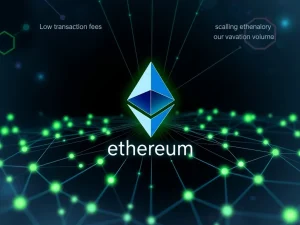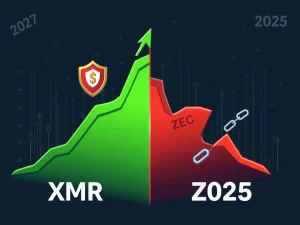MegaETH Unlocks Future: Pioneering Yield-Bearing Stablecoin on Ethereum L2

The cryptocurrency landscape constantly evolves, introducing groundbreaking solutions to existing challenges. One such innovation comes from MegaETH, a new Ethereum layer-2 protocol. This platform, notably backed by Ethereum co-founder Vitalik Buterin, is set to redefine the operational economics of layer-2 solutions. MegaETH recently announced the upcoming launch of USDm, a novel yield-bearing stablecoin. This strategic move aims to revolutionize how the protocol funds its operations and manages transaction costs, offering a fresh perspective on sustainability within the decentralized ecosystem.
MegaETH’s Innovative Approach to Funding on Ethereum L2
MegaETH stands out in the crowded field of Ethereum L2 solutions. Most layer-2s generate revenue primarily through transaction fees. However, MegaETH proposes a distinct business model. Its core innovation centers around the introduction of the USDm stablecoin. This digital asset is designed to generate yield, providing an alternative funding source for the protocol. Consequently, MegaETH aims to reduce its reliance on traditional transaction-based revenue streams, potentially leading to a more stable and user-friendly environment.
The development of the USDm stablecoin involves a significant partnership. MegaETH collaborates with Ethena, a prominent algorithmic stablecoin protocol boasting an impressive $13 billion in total value locked (TVL). This collaboration leverages Ethena’s robust USDt infrastructure. Importantly, USDt channels its reserves into BlackRock’s BUIDL, a tokenized US Treasury bill fund. BUIDL currently holds a substantial $2.2 billion market cap and consistently generates a steady yield, as reported by RWA.xyz. This integration ensures that USDm is backed by highly liquid and yield-generating real-world assets.
The USDm Stablecoin: A Game-Changer for Sequencer Fees
The primary function of the USDm stablecoin‘s generated yield is truly transformative. It will directly subsidize sequencer fees. Sequencer fees represent the Ethereum gas costs that a layer-2 protocol incurs when publishing batches of transactions to the main Ethereum chain. These costs are a significant operational expense for L2s. By using the yield from USDm’s reserves, MegaETH can offset these critical expenses. This innovative model significantly lowers the need for users to bear the full brunt of sequencer fees, instead drawing on an alternative, sustainable source of income.
Shuyao Kong, co-founder of MegaETH, emphasized the profound impact of this new stablecoin. Kong stated that USDm would “lower fees for users.” This directly addresses a common pain point in the blockchain ecosystem: high transaction costs. Furthermore, Kong highlighted that it would allow for “more expressive design space for applications.” This means developers could build more complex and feature-rich decentralized applications (dApps) without being constrained by prohibitive gas fees. Ultimately, this fosters greater innovation and utility on the MegaETH platform.
Understanding Yield-Bearing Stablecoins and Their Growth
Yield-bearing stablecoins are digital assets pegged to another asset, typically a fiat currency like the US dollar. What distinguishes them is their ability to generate yield for their holders. This yield often comes from underlying investments, such as tokenized treasuries or other interest-bearing assets. The concept has gained considerable traction recently, especially following regulatory shifts in the United States.
Specifically, the passage of the GENIUS Act in the United States has profoundly influenced the stablecoin market. This legislation imposes strict rules, banning issuers from offering yield-generating stablecoins under certain conditions. Consequently, this has created a unique market dynamic. Protocols that can navigate these regulations, or those operating in jurisdictions less affected, have seen a surge in adoption. Ethena’s USDe and Sky’s USDS have emerged as primary beneficiaries of these stringent rules, demonstrating the market’s demand for yield-generating opportunities within the stablecoin sector. MegaETH’s partnership with Ethena for USDm positions it strategically within this evolving landscape.
The Ongoing Debate: Ethereum Sequencer Fees and L2 Economics
The topic of sequencer fees has frequently sparked controversy within the Ethereum ecosystem. Many stakeholders believe the main Ethereum network should capture a larger share of the fee pie from layer-2 solutions. According to data from Token Terminal, Ethereum has collected approximately $1.1 billion in fees over the past calendar year. However, this amount has seen a notable decline since February. This fluctuating fee revenue highlights the economic challenges and ongoing discussions surrounding Ethereum’s long-term sustainability and the role of L2s in its scaling strategy.
The current fee structure impacts both users and developers. High fees can deter users from interacting with dApps, while unpredictable costs complicate development and business planning. MegaETH’s proposed model directly addresses this by internalizing the fee burden through yield generation. This approach could significantly alleviate pressure on users and enhance the overall user experience on the L2. It also represents a paradigm shift in how L2s might finance their operations, moving beyond a sole reliance on transaction processing fees. This innovative financial engineering could set a new standard for economic models within the broader blockchain space.
MegaETH’s Vision: Redefining Ethereum L2 Economics
The launch of MegaETH’s USDm stablecoin is more than just a new product; it represents a bold experiment in decentralized finance. By leveraging the yield from tokenized treasuries, MegaETH aims to create a more efficient and user-friendly Ethereum L2. This strategy could lead to consistently lower transaction costs for users, making the platform more accessible and attractive for a wider range of applications and activities. Furthermore, it allows MegaETH to differentiate itself from other L2s, which often compete primarily on speed and throughput.
This innovative funding mechanism could inspire other layer-2 protocols to explore alternative revenue models. As the blockchain industry matures, sustainable economic frameworks become increasingly vital. MegaETH’s pioneering approach with its yield-bearing stablecoin offers a potential blueprint for future L2 development. It demonstrates a commitment to long-term sustainability and user benefit, rather than short-term fee maximization. Ultimately, this move could foster a healthier, more robust ecosystem for Ethereum and its scaling solutions.
MegaETH’s introduction of the USDm stablecoin marks a significant development in the world of Ethereum layer-2 solutions. By funding protocol operations and subsidizing sequencer fees through generated yield, MegaETH is setting a new precedent. This strategy promises lower costs for users and opens up new possibilities for application design. As the blockchain industry continues to evolve, MegaETH’s innovative model could pave the way for a more efficient and sustainable decentralized future.










